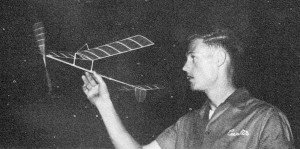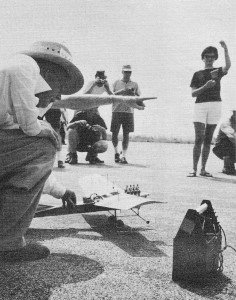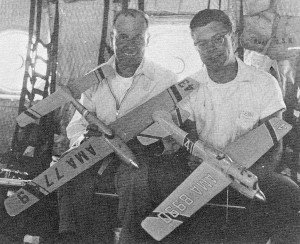|
An
extensive article introducing non-modelers to aircraft modeling
appeared in the Annual Edition of the 1962 American Modeler magazine.
15 pages were devoted to describing just about every aspect of model
building and flying - free flight gas and rubber; control line stunt,
combat, scale, and speed; helicopters and ornithopters; indoor gliders,
stick and tissue, and microfilm; even some early radio control.
In order to keep page length here reasonable (because of all
the images), the article is broken into a few pages. Pages:
|
10 & 11 |
12|
13 |
14 |
15 |16
|
17 |
18 |
19 |
20 |
21 |
22 |23
|
24 | For Non-Modelers: All About Air Modeling
20 Easy Ways to Go Crazy! <previous> <next>

Although paper-covered rubber powered plane looks like an indoor
flyer, it won outdoor events at California meets! Pop-up tail,
free-wheeling prop.

Sixty-six-year-old expert built free-flight-gas copy of 53-year-old
Antoinette monoplane.

Control line team racers can be two types, left, international
FAI class (with .15-size engine); right, AMA size with .29 power.
WAKEFIELD, RUBBER-POWERED - The rubber-powered
Unlimited and Wakefield (International Competition) designs are
the grownup versions of our small ready-to-fly wind-up R.O.G.'s.
In addition to the competition types there is quite a selection
of Intermediate rubber-powered sport kit models available. These
feature built-up construction, some are all sheet balsa, others
have partial open-work structures and tissue covering. Sizes range
from 15" R.O.G.'s to 30" span cabin types. There is a wide selection
of rubber-powered flying scale models also with spans up to 3 ft.
The rubber- powered contest types include: Wakefield, Unlimited
hand-launched, unlimited R.O.W. (Rise-off-water), Autogiros, Ornithopters
and Helicopters. The Wakefields and Unlimited designs are of built-up
construction. Spans and lengths range up to 4 ft. Structures are
similar to towline gliders, light, with numerous wing ribs and fuselage
cross-members, High-lift airfoils and large diameter folding propellers
are used. The rubber motor of a typical contest type may contain
as much as 24 feet of 1,4" flat rubber folded into 12 strands with
loops about 2 ft. long. Dethermalizers are employed to limit flight
duration as on towline gliders. Rubber motors are "stretch-wound"
to pack in the maximum number of turns giving maximum propeller
thrust and resulting higher climb. Motors are twisted with the aid
of a winder, usually a hand drill with a wire hook in the
chuck. Winder is hooked onto prop shaft. Motor is stretched up to
four times its normal length and winding beings. As the turns (500
to 1,0(0) mount up the winder is moved toward the model reducing
the strain on the rubber. Winder is unhooked from prop shaft, prop
is reo leased and model launched. Careful adjustment of flying trim
is needed to absorb power of the big prop and still maintain good
glide when power is used up. Climb is moderate compared to VTO engine
powered free flight, but rubber motor runs longer. Glide is comparable
to that of towliners and high altitudes and long flight duration
are achieved. Contest flight limits are set at 5 minutes so dethermalizers
are used, but duration in excess of 5 minutes is not unusual.
HELICOPTER, ORNITHOPTER, AUTOGIRO - Also
a part of outdoor rubber flying are the off-beat helicopters, ornithopters
and autogiros. There is limited interest in developing and flying
these types but they are fascinating in their performance and operation.
These types are also flown in indoor competition. Because of the
limited interest there are no kits for these odd-balls, magazine
plans being the sole source of data for building. The helicopters
usually take the form of the familiar Ceiling Walker, but larger.
Rubber motor is enclosed in a long slender body with large propeller
at each end. One prop is stationary on body while other is turned
by the rubber motor. Both body and powered propeller revolve giving
a contra-rotation action to the propellers to gain stability. No
wings, but short stabilizing fins on body are sometimes used. Flight
is straight. up and straight down. The ornithopter (flying
wings) is a true aeronautical curiosity since it has no current
counterpart in full scale aviation. Lifting power is gained solely
by the flapping of the wings like a bird. The rubber motor moves
the hinged wing panels by a system of cranks and rods. Models are
usually of tractor configuration with a portion of the wing being
stationary. Flight is slow and of limited duration, no dethermalizer
problems here. The autogiro utilizes one set of free turning
rotor blades to gain lift. These are mounted to revolve in a horizontal
plane above the fuselage. Forward thrust is gained by a conventional
propeller. Tails are in the usual place and short wings are sometimes
employed. While a rubber-powered autogiro is a rare bird indeed,
there is some interest in their engine-powered counterparts.
ROCKET
FREE FLIGHT - To date the only safe practical true rocket
engines developed for model use are the Jetex units. Originated
in England the Jetex reaction engines use solid propellant fuel
ignited by a fuse (or wick). The engines are lightweight metal and
can be taken apart for cleaning and insertion of fresh fuel charge.
The largest Jetex engine "600A," develops 8 to 8.5 ounces of thrust
for 30 to 35 seconds. The small "50" delivers .7 to .8 oz. of thrust
for 12 to 16 sec. The popular "150" gives 2 to 2-1/2 oz. thrust
for 20 to 25 sec. The limited amount of thrust delivered requires
a very lightweight model if good performance is to be achieved.
Model structures and configuration are typical of those used for
towliners and other free flight designs. Rocket free flight
contest regulations limit maximum engine size to the "150" and models
for this engine usually have about 2 to 3 foot span. Until recently
Pan American Airlines firm sponsored and championed model competition
events utilizing the Jetex 50 and 150 engines. The PAA-LOAD contest
idea required that a dummy pilot (or cargo) of specified weight
be carried aloft. Length of flight duration determines the winner.
In addition to the contest models there are also kits available
for space rockets, missiles, scale jets and simple sport flyers
all designed for the various Jetex rocket units. <previous> <next>
Posted December 25, 2010
|